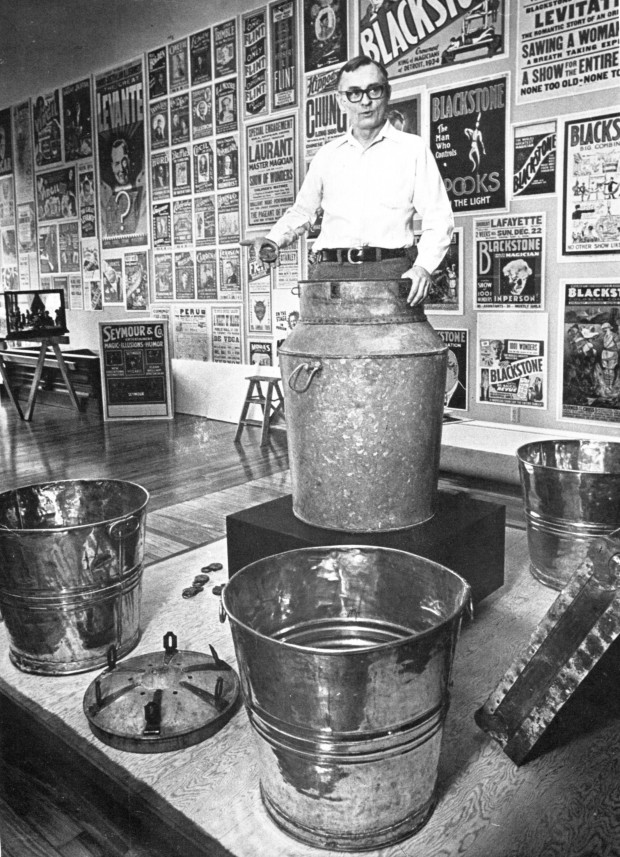
Bob Lund 1979 with the famed Milk Can.
The final performance of the Houdini/Hardeen Milk Can Escape – using the original apparatus in the collection of the American Museum of Magic – will be presented by escapologist Joseph Patire on Saturday evening, May 30th as a part of the Midwest Magic History Weekend.
“This is an unbelievable turn of events,” said David Charvet, Producer of the History Weekend. “I have been negotiating with the Museum board for months. They are rightfully very protective of the apparatus, which has not been filled with water in many years.”
Houdini debuted the escape at the Columbia Theater in St. Louis on January 27, 1908 after the manager of the theater told the Handcuff King that his manacle escapes were becoming old hat. The galvanized steel can, resembling an oversized milk can, was examined by a committee from the audience and filled with water. Houdini folded himself into the tight confines of the can and ducked his head below the water as the lid was quickly slammed in place and secured with six padlocks.
The can – with Houdini submerged inside – was surrounded by a cloth cabinet as the seconds ticked by. After three minutes a gasping, dripping Houdini appeared from the enclosure, revealing the can still securely locked with no indication of how he had made his escape.
The feat became the feature of Houdini’s act through 1911 when he developed his famous “Water Torture Cell” that he performed up until his death in 1926.
Houdini’s brother, Theo Hardeen first performed the escape in about 1914 but retired from the stage several years later to head Houdini’s Film Development Company. Following Houdini’s death, all of his props were willed to Hardeen, who returned to vaudeville and again began performing the Milk Can escape.
For the next 18 years Hardeen presented the Milk Can as the closing feature of his show, actually performing it more times than Houdini. He had several close calls where he had to be released from the can before he made his escape.
Hardeen’s final performance was on May 30th, 1945 at the RKO Madison Theater in Brooklyn. He featured the Milk Can in that last show. 13 days later, on June 12, 1945, Theo Hardeen died at age 69.
Following Hardeen’s passing two of his Milk Cans were acquired from his estate by magician, Martin Sunshine. The cans were stored in a truck in Three Lakes, Wisconsin for thirty years until one was purchased by Robert Lund, founder of the American Museum of Magic, where it has been the centerpiece of the museum from its opening in 1978.
The performance on May 30th marks the 70th anniversary – to the day – of Hardeen’s final show in 1945. “Bob Lund allowed several people to attempt the escape over the years, but the can was never filled with water,” said Charvet. For the first time since Hardeen’s time, the can will be filled with water on the upcoming show. “There is a real element of danger presenting a water escape with equipment this old. The museum has assured me that they will never allow the Milk Can to be filled with water or performed again after this show on May 30th.”
Chosen for the honor of the final performance is magician and escape artist, Joseph Patire. No stranger to water escapes, he has presented variations of the Milk Can in the past. “But to perform it with an original Houdini-Hardeen can – and knowing I will be the last person ever to do so with this can - is a real honor,” Patire said.
The escape attempt will be the climax of the Magic History Weekend, a three-day gathering of magic historians and collectors from around the world. The show will be held at the Franke Center for the Arts, 214 E. Mansion Street, in Marshall, Michigan on Saturday, May 30th at 7:30pm. Limited tickets are available to the public by contacting Susan Collins at the American Museum of Magic: 269-781-7570.
Details about the Magic History Weekend are at: www.MagicHistoryWeekend.com
***
Contact:
David Charvet
503-309-7729
info@magichistoryweekend.com


